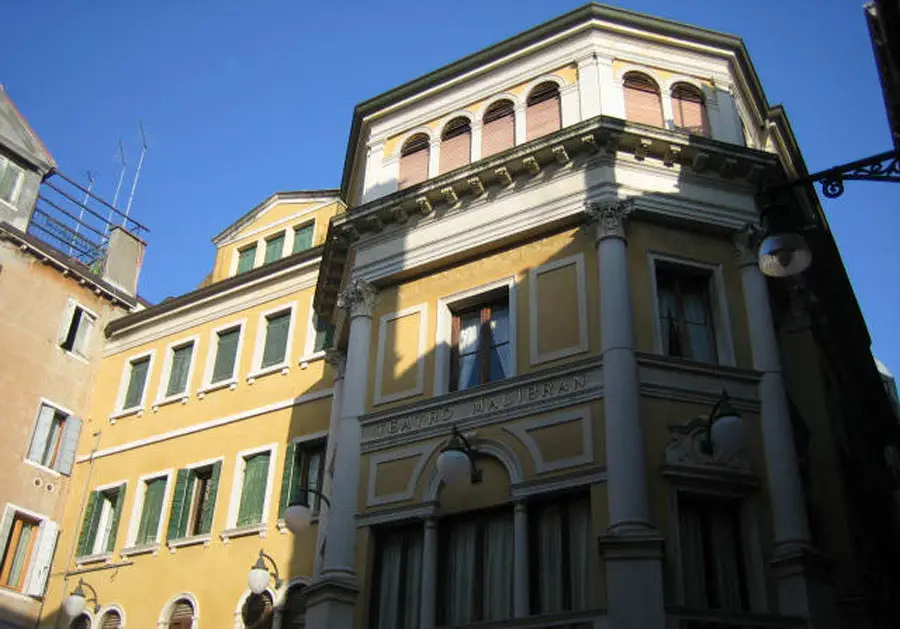| In Venice Today.com |
|
||
|
|
|||||||||||||||||||||||||||||||||||
|
|||||||||||||||||
Theatre Malibran in VeniceThe Theater Malibran in San Marco, Venice: the calendar of the season, the shows, the hours, the cost of the tickets, the seat. |
|||||||||||||||||
|
|||||||||||||||||
 Theater Malibran - Campo San Fantin, San Marco 1965 - Venice
Theater Malibran - Campo San Fantin, San Marco 1965 - VeniceLiric Season 2018/2019 - 8, 10, 12, 14, 16 febbraio 2019 - Il sogno di Scipione, Wolfgang Amadeus Mozart - 7, 8, 9 marzo 2019 - La Statira Tomaso Albinoni - 21, 22, 23 marzo 2019 - Pimpinone Tomaso Albinoni - 23, 27, 30 aprile 2019 2, 5 maggio 2019 - DORILLA IN TEMPE Antonio Vivaldi - 13, 14, 18, 22, 24 settembre 2019 - Luci mie traditrici Salvatore Sciarrino Symphonic Season 2018/2019 - sabato 10 novembre 2018 ore 20.00, domenica 11 novembre 2018 ore 17.00 direttore KEREM HASAN Commissione �Nuova musica alla Fenice� con il sostegno della Fondazione Amici della Fenice prima esecuzione assoluta Giovanni Battista Viotti, Concerto per violino e orchestra in la minore n. 22, Ludwig van Beethoven, Sinfonia n. 4 in si bemolle maggiore op. 60, violino Enrico Balboni, Orchestra del Teatro La Fenice - venerdì 7 giugno 2019 ore 20.00, sabato 8 giugno 2019 ore 17.00 direttore JONATHAN WEBB, Commissione «Nuova musica alla Fenice» con il sostegno della Fondazione Amici della Fenice prima esecuzione assoluta Wolfgang Amadeus Mozart, Concerto per pianoforte e orchestra n. 17 in sol maggiore kv 453 Ralph Vaughan Williams A London Symphony pianoforte Francesco Granata vincitore Premio Venezia 2017, Orchestra del Teatro La Fenice History of the Theater Malibran Inaugurated during the Carnival of 1678 as the Teatro San Giovanni Crisostomo was judged immediately as the best theater in Venice (1683). Designer was Tommaso Bezzi, called Stucchino for his qualities as a painter and engineer, to whom the Grimani, owners of other theaters in the city, gave an area between the church of San Giovanni Crisostomo and the Corte del Milion where once stood the Polo family house. The Venetian seventeenth century was characterized by a proliferation of theaters due to the opening to the people of a genre that was previously thought of for the exclusive benefit of the aristocracy: the opera. Despite this cultural policy of the city, the Malibran Theater kept the costs of entry, thus selecting its audience and becoming a privileged meeting place for the Venetian and foreign aristocracy arriving in Venice. On his stage passed singers of the caliber of Farinelli, Caffarelli and Tolve and were represented works by Metastasio (Siroe), Zeno and Goldoni. With the fall of the Republic (1797) the Theater was granted to the municipality meeting a period of crisis in the sector also underlined by a ministerial decree of the Italian Kingdom that limited to four the number of theaters opened in the city: the Phoenix, the San Benedetto , the San Mois� and the Malibran. Probably all this led the Grimani to leave the scene in favor of Luigi Facchini and Giovanni Gallo who acquired the San Benedetto and the Malibran, inaugurating the new course with the representation of Rossini's Gazza ladra. Subsequently, a restoration of the building was also decided which led to a new inauguration with Donizetti's L'elisir d'amore. The Gallo (1835) managed to write the most famous singer of the period Maria Garc�a Malibran, who performed for free, receiving in recognition from the same Gallo the privilege of giving the name to the theater. 1844 saw the arrival of the successor Giovanni Gallo who made changes to both the programming, including many operas, both the interior of the room, the decoration and the points of light. After the dark years of the Austrian domination that saw the theaters closed in protest the Malibran returned to the limelight with the representation of a Mass by Verdi (1875). In 1886 the Malibran theater was auctioned off and acquired by Francesca Baldanello, Emerico Merkel and Giuseppe Patrizio who, through their heirs, maintained the property until a few years ago. In 1890 the new Malibran was inaugurated again but urgent problems of stability of the building led to the decision to undertake the complete reconstruction that was entrusted to the project of engineer Mauro Felice Donghi. After the obvious pause due to the bursting of the first world war, the Malibran Theater was inaugurated in 1919 with the representation of Verdi's Otello. Throughout the twentieth century the Malibran programming continued without interruption and turning towards the evolution of the theater including dance performances (Carolyn Carlson, Pina Bausch). In 1992 the Malibran was purchased by the City of Venice who planned the restoration of some parts of the building and its interior but the fire of the Fenice Theater and the urgency of moving to the Malibran part of its theatrical programming led to a modification of the original project. Despite this, the facilities were modernized and the orchestra pit was expanded. The work of the foundations for the construction of a tank against high water also brought to light Roman remains dating back to the 5th century AD. interpreted as landing points, which can already rewrite the history of the Rialto area in Late Antiquity. Phone: +39.041.786511 Address: Campiello del Teatro, Cannaregio 5873 - Venice E-mail: info@teatrolafenice.org Website: Teatro Malibran |
|||||||||||||||||